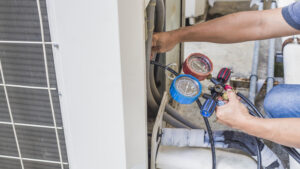How Have Heat Pumps Changed Over Time in Sebring, FL?
Heat pumps are impressive devices that provide countless indoor comfort benefits to millions of people living in Sebring, FL , nd beyond. Their power, versatility and efficiency, in comparison with standard HVAC systems, make them a truly monumental engineering achievement. But to really appreciate them, it pays to place them in a historical context and see the factors that shaped their development.
A Long Road From Refrigeration
Humans have had to fight against difficult weather for their entire history, and it’s impossible to discuss these many efforts in full detail here. Until relatively recently in history, most human efforts at indoor climate control were either passive (building large rooms) or involved using fire to stay warm.
In the 16th and 17th centuries, some scientists made a few important discoveries about how to cool the air artificially, but we were still a long way from anything like heat pumps. Later, in 1748, the Scottish doctor William Cullen created a pump-operated refrigeration machine that some might call an early ancestor of the heat pump. The device produced a vacuum over a diethyl ether solution, draining out the heat.
In the 1800s, the Americans Oliver Evans and John Gorrie made some important advancements in refrigeration, but the critical transitional figure of the century was the British physicist, Lord Kelvin. In 1852, thanks to his work in thermodynamics, he theorized that the same principles that could cool an area could also — if reversed — warm it. This is the idea that eventually made true heat pumps possible.
Heat Pumps Finally Arrive
All of these previously mentioned developments finally culminated in the work of the Austrian mining engineer Peter von Rittinger, the man who created the world’s first heat pump in 1856. Von Rittinger intended his machine to dry salt brine in Austrian salt marshes, so his invention had an exclusively industrial application. Residential heat pumps would have to await the arrival of the 20th century.
Finally, in 1945, the English engineer John Summer made the decisive breakthrough when he constructed a water-source heat pump whose purpose was to heat and cool the central office of the Norwich City Council Electrical Department in England. Three years later, the American Robert Webber stumbled upon a design for a geothermal heat pump when trying to increase the power of his freezer. All the necessary technology was now in place, but some time would pass before it spread.
The spur to its acceptance was the 1970s energy crisis. Prior to this, England and the United States had access to abundant hydrocarbon resources, making investment in electrically powered heat pumps seem pointless. But after fossil fuel prices exploded in the 1970s, governments began pushing for investment in alternative energy sources, finally leading to the progressively wider use and adoption of residential heat pumps.
Leading Into the Modern Day
The main effect of this government-orchestrated incitement was to make heat pumps and other types of HVAC systems more efficient, more powerful and, hence, more affordable. This continued gradually through the 1980s and 1990s as environmentalist ideas also spread through society.
By the early 2000s, the importance of energy conservation had become a mainstream concept. Later in that decade, smart thermostats finally burst onto the scene, and we saw the most recent advancement that brought heat pumps to where they are today: the advent of smart technology.
In earlier decades, people typically only used heat pumps in milder climates. Now that these systems have become more powerful and operate with great precision, they can bring people comfort in places all over the world.
Now, heat pumps are an integral part of the HVAC market, with their own dedicated senior service technicians and specialized companies offering installation, repair and maintenance services. Since many have committed to developing technologies that economize energy and don’t pollute, heat pumps have become particularly attractive.
We’re proud to work in this industry and supply our customers with services for these marvelous and capable machines. No matter what kind of heat pump services you require in the Sebring, FL, area, call Miller’s Central Air, Inc. today.
Image provided by iStock
You May Also Like

Need a Commercial HVAC Repair in Stuart, FL? Don’t Delay!
When your commercial HVAC system falters during the busiest season of the year, every moment counts. The warm Florida sun beating down… Continue Reading Need a Commercial HVAC Repair in Stuart, FL? Don’t Delay!…

Winter Indoor Pollutants Common in Port St. Lucie, FL
While neighbors string lights and celebrate the season, an invisible threat lurks inside Port St. Lucie, FL, homes. Sealed windows trap stagnant… Continue Reading Winter Indoor Pollutants Common in Port St. Lucie, FL…

What’s Ductless Heating and Cooling in Jenson, FL?
November mornings in Jensen, FL, go something like this: you reach for a light sweater at dawn, only to crank up the… Continue Reading What’s Ductless Heating and Cooling in Jenson, FL?…
